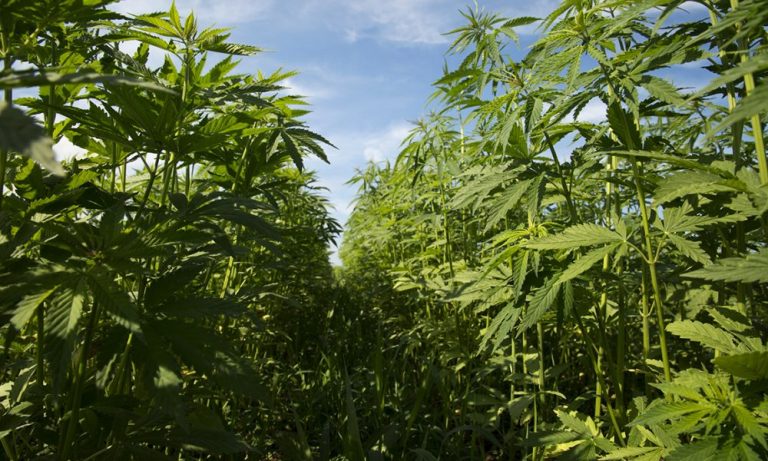“Increasing the THC level to 5 percent would hinder our successful hemp program and undermine enforcement of our drug laws.”
By Makenzie Huber, South Dakota Searchlight
Gov. Kristi Noem (R) vetoed a bill Thursday that would increase the amount of THC that industrial hemp processors can have in their products.
THC is short for tetrahydrocannabinol, the compound in cannabis plants that produces a high when present in sufficient amounts. Hemp, unlike its cousin marijuana, is low in THC. Hemp plants can be used in a multitude of products.
Noem said the bill would “jeopardize the effectiveness and safety” of the state’s industrial hemp industry “by creating conflict with federal law while also allowing marijuana products to be considered hemp products.”
Today, I VETOED HB 1209.
South Dakota has a safe and responsible hemp program that we have worked many years to implement properly.
This bill would jeopardize the effectiveness and safety of our program by classifying marijuana as hemp. pic.twitter.com/YczofNW9Ok
— Governor Kristi Noem (@govkristinoem) March 23, 2023
Legislators will return to Pierre on Monday to consider the hemp veto and other vetoes from Noem. It takes a two-thirds vote to override a veto. Earlier this winter, the House of Representatives passed the bill in a 44-26 vote while the Senate passed it in an 18-16 vote.
Under current state law, up to 1 percent of THC is allowed in a hemp “product in process,” which is already over the federally recognized limit of 0.3 percent. The “product in process” definition includes hemp that’s being transported from one place to another during processing.
The bill would increase the limit to 5 percent.
“If I allowed this bill to become law, it would jeopardize the clearly expressed will of the people,” Noem said in a statement, referencing the failed 2022 ballot measure to legalize recreational marijuana. “Increasing the THC level to 5 percent would hinder our successful hemp program and undermine enforcement of our drug laws.”
Today, I VETOED HB 1209, which would increase the amount of THC allowed in hemp to 5%, classifying marijuana as hemp.
South Dakotans spoke clearly this past November: they do not want recreational marijuana. Signing this bill would go against the will of the people. pic.twitter.com/wQMHDthBDk
— Kristi Noem (@KristiNoem) March 23, 2023
Noem also argued that the change would increase the THC level for crops in the field.
“That’s absolutely a lie. That’s not true,” said Rep. Oren Lesmeister, D-Parade, the bill’s prime sponsor in the House. “The only time we’re allowing it above 0.3 percent is processor to processor. Crops are still under 0.3 percent, biomass is still under 0.3 percent and end products are still under 0.3 percent.”
The higher THC levels are temporary, Lesmeister explained, and tied to the production of hemp-derived products. While hemp plants in the field have a THC below 0.3 percent, processors have concentrated levels of THC when extracting oils and CBD from the crops for products such as lip balms, oils and lotions.
Those higher levels of THC are all but unavoidable in the production of consumer hemp products, Lesmeister said. Processors themselves are not federally regulated, and other states with hemp processors “turn a blind eye” to processing-related concentrations over 0.3 percent, Lesmeister said. South Dakota would join two other states, Colorado and New York, were it to allow the 5 percent limit.
Lesmeister is not a hemp farmer but plans to plant the crop in the future. The 2023 legislative session is the second time he’s introduced the bill.
The 1 percent level was a compromise when the hemp program started, Lesmeister said. But processors exceed 1 percent THC “pretty much every time” before THC levels are reduced again when processing is finished. Raising the limit to 5 percent would ensure processors are producing legally, and Lesmeister said this veto could “stifle the industry.”
“If we could have zero THC in our hemp products, we’d love that,” Lesmeister said. “It’s a pain in our butt. We don’t want THC. We just want the CBD and the isolates and the oil. But when you extract, you concentrate the oil and that raises the THC level.”
South Dakota had the second-most industrial hemp acres in the nation in 2022, following Montana, according to reporting citing the South Dakota Industrial Hemp Association. The state increased harvested yields in 2022 by 35 percent to 2,540 acres, up from 1,674 in 2021.
“There are people processing in the state who don’t want to do anything wrong,” Lesmeister said. “They can’t get crop insurance on it yet. There’s no safety nets like all the other crops.”
This story was first published by South Dakota Searchlight.
Photo courtesy of Brendan Cleak.
